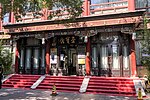Huguang Guild Hall
1807 establishments in ChinaChinese opera theatresMuseums in BeijingMuseums with year of establishment missingPeking opera ... and 4 more
Performing arts venues in BeijingTheatre museums in ChinaTheatres completed in 1807Xicheng District

The Huguang Guild Hall (simplified Chinese: 湖广会馆; traditional Chinese: 湖廣會館; pinyin: Húguǎng huìguǎn; lit. 'Huguang Assembly Hall') in Beijing is one of Beijing's most renowned Beijing opera (Peking opera) theaters.
Excerpt from the Wikipedia article Huguang Guild Hall (License: CC BY-SA 3.0, Authors, Images).Huguang Guild Hall
骡马市大街, Xicheng District Taoranting (首都功能核心区)
Geographical coordinates (GPS) Address Nearby Places Show on map
Geographical coordinates (GPS)
| Latitude | Longitude |
|---|---|
| N 39.8875 ° | E 116.3777 ° |
Address
骡马市大街
骡马市大街
100032 Xicheng District, Taoranting (首都功能核心区)
Beijing, China
Open on Google Maps








